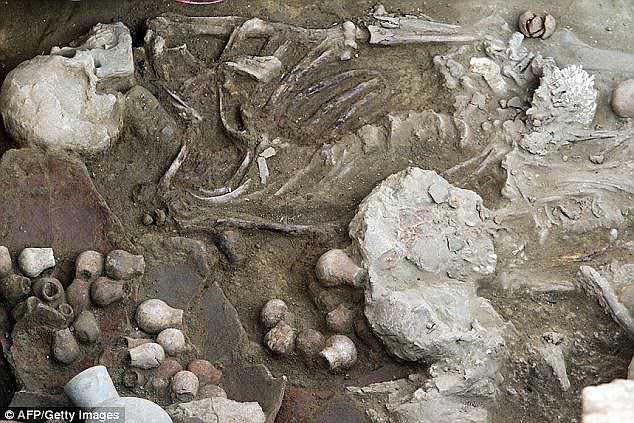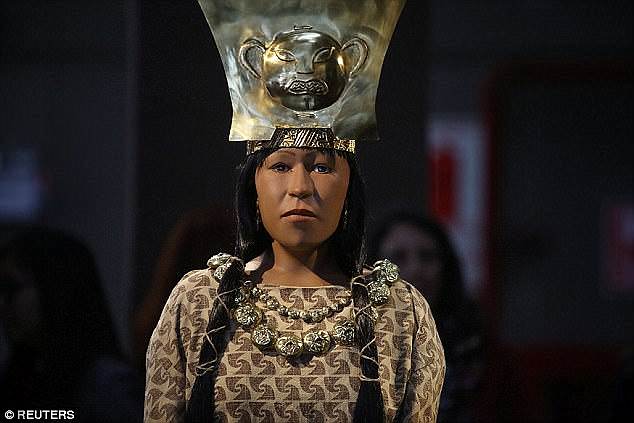Ancient Peru was dominated by fearsome female monarchs who wielded as much power as their male counterparts for thousands of years.
Research suggests women in pre-Columbian Peru played a vital role in tribal politics and were not ‘left out’ of governing decisions as some historians believe.
Previous studies have suggested high-ranking women in ancient Peru were mere ‘priestesses’ who, while skilled and highly valued, held little political influence.
But in a new book ‘Woman, power and food in ancient Peru’, historian Maritza Villavicencio suggests that sexist attitudes within the research community mean female monarchs don’t get due credit for the power they once wielded.
Ms Villavicencio looked at female and male remains buried in pre-Hispanic Peru – a vast time period that stretches from 9,500 BC to around 1,500 AD when the country was invaded by the Spanish.
In her book, she argues that women exercised political power in their communities in many different areas of pre-Hispanic Peru, including among the Moche people.
The Moche Civilisation lived on the Northern coast of what is now Peru between 50 AD and 700 AD.
‘Women were categorised as priestesses to lower their status – not as a person who had power to participate in their people’s political, economic and social activities, able to decide and make alliances with Moche rulers,’ she told AFP.
‘There is a discriminatory interpretation by researchers regarding women in ancient Peru which obscures the power of these women.
‘Women were invisible in history, and what my book does is propose restoring the memory of the real life of these women. That’s why this is more than just a claim.’
The book, published by San Martin de Porres University in Lima, is the result of 10 years of research into the clothing, body art and burial rituals of ancient Peruvians.

Traditional books of Peruvian history have said that women were absent when governing decisions were made, but her research shows the opposite, she said.
Ms Villavicencio said lineage was a principal criterion for assuming power.
There were also four areas in which power was attributed to individuals: Miracle-working, reproduction, textile-making, and supplying food.
Women’s ‘power to heal, to summon the weather through knowledge, to show the path of life and death made them leaders,’ she said.
An important symbol was the tattoo.
‘For example, the Lady of Cao had serpents tattooed on her arm, which signified she able to summon water from the rivers and possibly predict the weather,’ she said.

There are also sanctuaries in which the remains of elite women have been discovered, such as at a site in the Lima neighborhood of Miraflores called Pucllana, or a nearby site in San Isidro.
The San Isidro site, Huallamarca, in 1958 yielded funeral remains of around 100 people, 73 of whom were elite-level women, among the Lady of the Long Hair – or la Dama de los Cabellos Largos.
The buried remains of men were also found, but they were of lower rank.
Archaeologists have also dug up much evidence of textile making. Ms Villavicencio said that cloth mantles were believed to confer power to women in ancient Peru.
Peru’s powerful female monarchs have largely been written off by historians as minor players within their tribal hierarchy despite evidence to the contrary, she said.
The first Peruvian mummy of a high-status woman was discovered in 1992 at an archaeological site in San Jose del Moro, home to the people of the Late Sican period who lived there between the 12th and 14th centuries.
The figure had long been considered a high priestess, though she was buried wearing the clothes of a ruler.
From 2013, experts began to call the woman – who was buried alongside eight other elite noblewomen – the ‘Senora (Lady) of Chornancap’, Ms Villavicencio said.
In 1987, archaeologists discovered what came to be known as the Lord of Sipan, near the modern day city of Trujillo.
‘Nobody called him a “priest.” Everybody called him a great lord, the Moche monarch, and a museum was built for him,’ Ms Villavicencio said.
A separate Peruvian find, a woman known as the Lady of Cao who governed in the 4th century during the Moche culture, was also originally labelled a priestess despite being buried with a sceptre similar to that found at the Lord of Sipan’s tomb.
After further study, the Lady of Cao was considered a ruler, and today she has a museum in her honour.
‘There is a biased view when it comes to women, a male-centric vision that puts men at the center of everything in Peru’s history,’ Ms Villavicencio said.












